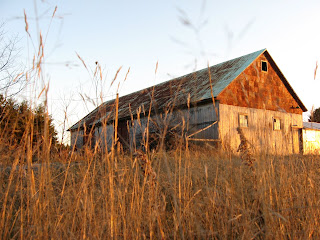
It was when I brought home the Blue Hubbard that I began to wonder if I had gone too far.
At least a foot and a half long from end to end, it was roughly spherical in shape but with two blunt protrusions on either side. Its skin was a pale bluish gray in color, and covered all over with warts. My mom said it reminded her of a baby seal. I though maybe an alien from outer space was more accurate. It was a squash, the strangest squash I had ever seen, and apparently it was edible -- at least, according to the woman at the farmers' market.
At home, over the years, we had had the occasional butternut or acorn squash for dinner, purchased at Stop & Shop and roasted, invariably, with brown sugar. It did not leave me with a great appreciation for winter squash. But Sue, the vegetable farmer in British Columbia, grew quite a lot of winter squash -- if you've been paying attention to the blog, you'll recall the bruises left on my hands from trying to catch the several-pound thick-skinned vegetables hurtling through the air -- and one day, towards the end of my stay on her farm, we had a squash tasting for dinner. Three squash varieties, simply roasted and cut into strips. There was the butternut, moist and stringy; and then the red kuri, dry, with a flaky texture; and the forest-green-and-cream-striped delicata, one of the few winter squash whose skin is edible. I began to wonder if there might be more to this humble vegetable than I had previously thought.
(It's one of the cliches of food writing to refer to a vegetable as "humble" -- but who's ever seen an arrogant vegetable?)
When I returned to Larchmont, I was more eager than ever to patronize the farmers' markets, having learned firsthand how much hard work goes into producing vegetables the old-fashioned way (and I was more than happy to pay someone else to do the hard work for me). But farmers' markets in late November and early December can be a rather dreary sight: potatoes, carrots, onions, kale, and other hardy yet hardly exciting vegetables. The few straggling tomatoes are likely to be mealy and soft, good for little except cooking -- a far cry from the firm, bursting-with-flavor heirlooms of early fall that provide the most compelling reason for shopping at a farmers' market.
So I suppose it was only natural that my enthusiasm found a different vein: the winter squash, whose considerable breadth of shape, size, color, taste, and texture is on full display in the late fall. Squash, for those of you who don't know, is usually divided into two categories: the thin-skinned summer squash, which must be eaten within a week or two of harvesting, and the winter squash, which (as its name suggests) is harvested later in the year and can generally be stored through the winter. The feeble zucchinis and pattypans having long since bit the bucket, it is the winter squash that concerns me here.
I started off slowly. Well, that's a lie. My first weekend at home, I brought home about five squashes from the farmers' market. Three butternuts, plus a delicata and a kabocha, a dark green warty Japanese variety. We made an effort to incorporate squash into every meal -- stuffed with cauliflower or with rice, sliced thin and roasted or incorporated into a soup with some leftover turnips from Thanksgiving. Most of these dishes were improvised, since the squash recipes in the cookbooks in our kitchen seemed to begin and end with butternut squash soup. And I was determined to be more creative than that. But as the weeks went by, the squashes seemed to pile up faster than we could eat them.
And then I brought home the Blue Hubbard.
It sat on our kitchen counter for several days before I attempted to make use of it. Part of the reason for the delay was that I had to determine the best approach. Usually, with a winter squash, you cut it in half before baking it. But this squash was big enough to foil even the most formidable knife. Perhaps I had also become a bit attached to my squash/baby seal. I held it in my arms and took pictures of it. It seemed almost alive -- in a warty, ugly, alien way.
Still, it was taking up valuable space on the kitchen counter, and I knew it had to go sooner or later. I did a little bit of research online and found that the recommended technique for dealing with a recalcitrantly massive squash was to drop it on the floor. It'll break right open, they said. So I wrapped my Blue Hubbard in a garbage bag and took it out to the driveway (I didn't want to bust a hole through the kitchen floor, after all).
I held it at arm's length, so as to not accidentally break a toe, and let it fall. Upon examination, I found that one of the knobby protrusions had broken off, but the main body of the baby seal remained intact. Evidently, a more forceful impact was required. So I picked it up and (pausing briefly to wonder if the neighbors were watching) threw it against the ground. This time, it broke. I guess that what I had read on the internet had led me to believe that the squash would split evenly into two halves. In actuality, I ended up with about eight or nine irregular pieces. But at least now it was open.
I baked the squash, scooped out the flesh (it was bright orange, incidentally) and put it in the blender. I ended up with maybe three pints of squash puree, two-thirds of which is still sitting in the downstairs refrigerator.
I wish I could tell you that that was the end of my squash-purchasing. But the squashbuckling adventure did not end there. On a trip to the Union Square farmers' market last week, ostensibly to buy some cauliflower for an Indian dish I was going to cook for my family, I came away with no cauliflower but five squashes -- a green-and-yellow-striped acorn variety, a buttercup (distinct from the familiar butternut, and supposedly the king of winter squashes), an Italian variety called Chioggia, and a couple of small green-striped squashes whose name escapes me. I knew about the Chioggia squash from an Italian squash cookbook I bought from a cookbook store on the Upper East Side. I had always thought of squash as a strictly New World vegetable, and the British and French and German people I met over my gap year confirmed that winter squash was not often eaten in their parts of Europe. But apparently there was domesticated squash in Italy from the time of the Roman Empire.
It didn't bother me that the mound of winter squash on our counter kept growing bigger and bigger, though I began to sense a reluctance on the part of my parents to supply me with any more squash-purchasing money. We didn't need to eat all of the squash right away, I reasoned; we could keep it as long as we wanted -- all winter, even -- and cook it whenever we got around to it.
But then something happened which is not supposed to happen -- my winter squash started to get moldy. A couple of theories were brought forward to account for this unaccountable catastrophe. Perhaps a bunch of bananas, stored in too close proximity to the squash, emitted some kind of chemical that hastened the squash spoilage. This was my dad's favorite explanation. Or perhaps there was something funny in that Chioggia squash I brought home from Union Square -- it seemed to be leaking out the bottom. But no, the first squash to go bad was a red kuri I had bought at the Larchmont farmers' market a week earlier.
Just in this last week our winter squash herd has been culled from about seven down to just two. Part of this squash reduction was due to increased consumption -- sometimes two squash courses in the same meal -- but much of the squash just had to be thrown out. I salvaged as much as I could, but the Chioggia was, sadly, completely beyond recovery. I fear that my appetite for winter squash has been dulled somewhat by all of the moldy spots I had to dig out, the squishy sections that went to compost.
But is this the end of my squashbuckling adventure? Hardly. There's still a couple of pints of Blue Hubbard puree in the basement.























